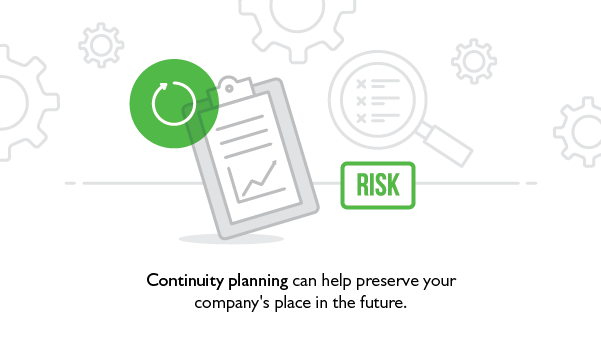Business disruption can come in many forms, whether as a pandemic, natural disaster, data breach, recession, fire or some other emergency or loss. The reality is that the risks will always be there, which is why your business needs to undertake comprehensive continuity planning.
Sometimes, this task can feel like an exercise in simply checking the boxes, unless you’ve already experienced a significant disruption. Things can change in the blink of an eye, even entire industries can be shut down.
Continuity planning can help preserve your company’s place in the future, but it takes hard work, time and effort. To help, let’s look at four core steps to effective business continuity planning and what you can do.

1. Understand the risks
The very first thing you need to do is understand what risks your business is exposed to. These can range from macro concerns like an economic downturn or a national pandemic to more focused risks such as hurricanes (if you’re located on a coast) or data loss due to a targeted breach or cloud outage.
Take some time to conduct business impact analysis (BIA). Essentially, this involves breaking down your business into specific processes and systems (e.g., supply chain operations, vendor relationships, data storage) and what risks exist, what outcomes may occur and how resilient each process or system is.
This thorough accounting and dissection of your business will help you identify potentially fatal risks and in general provide the insight needed for detailed continuity planning.
2. Make contingency plans
Now that you know what could go wrong, it’s time to make specific plans for what to do if such scenarios come to pass.
Don’t know where to start? Ready.gov is a government website full of information, resources, videos, toolkits and more. You can use Ready.gov to jumpstart your contingency planning and take concrete steps toward codifying a plan of action.
If you’re new to such planning, it may also help to work with your bank or a consulting party. Your financial institution can likely offer advice and tips on continuity planning, while a consulting service may draw up the plan with you.
3. Run exercises and what-ifs
If a disaster or disruption strikes, you’ll want to be able to implement your response as quickly and efficiently as possible. However, that can be hard if you and your employees haven’t had at least a dry run.
Once you have your plans established, it’s worthwhile to walk through them and even conduct mock scenarios so everyone is on the same page and clear on how to respond to the event.
Two useful types of exercises are:
- Table-top exercise: You and your team gather to read through the plan, essentially play-acting their roles and responsibilities during a disaster. This forum is useful for asking questions and collaborating on more effective solutions.
- What-ifs: This involves asking “what if” at different points during a contingency plan if things don’t according to script. This can help your business better tackle unanticipated risks or disruptions.
4. Update your plan accordingly
A static plan is no good. The world is ever-changing, and your continuity planning will need to reflect that dynamic nature. It’s valuable to have fixed points at which you review your plan and make any necessary updates; this may be annually, biannually or even quarterly.
If you happen to go through an adverse event, don’t forget to update your plan. It may take a backseat to operational concerns in the immediate aftermath, but you’ll have valuable insight and practical experience that can enhance your planning.
Need help with outlining or refining your continuity plan?
Contact Bank Midwest today for assistance.
